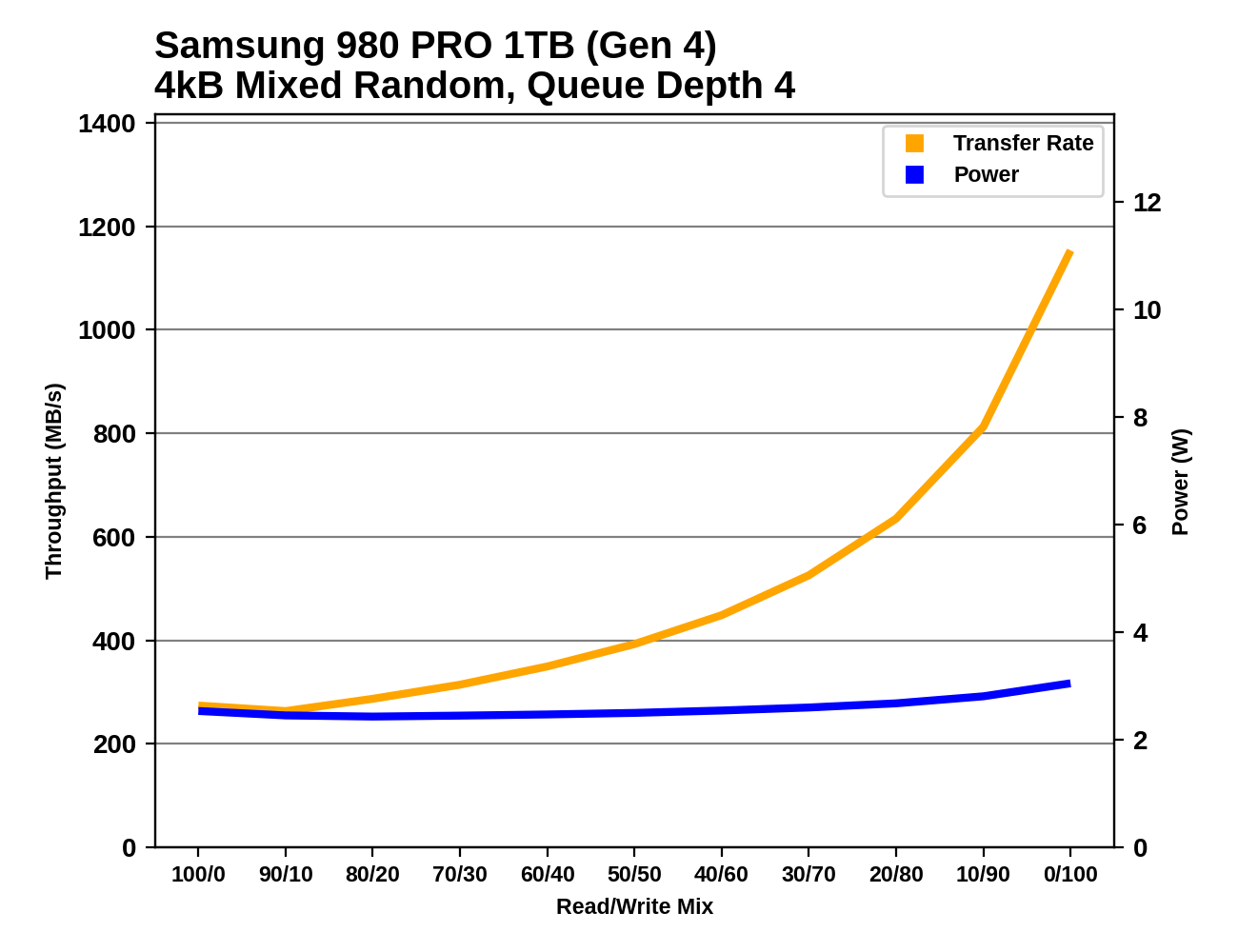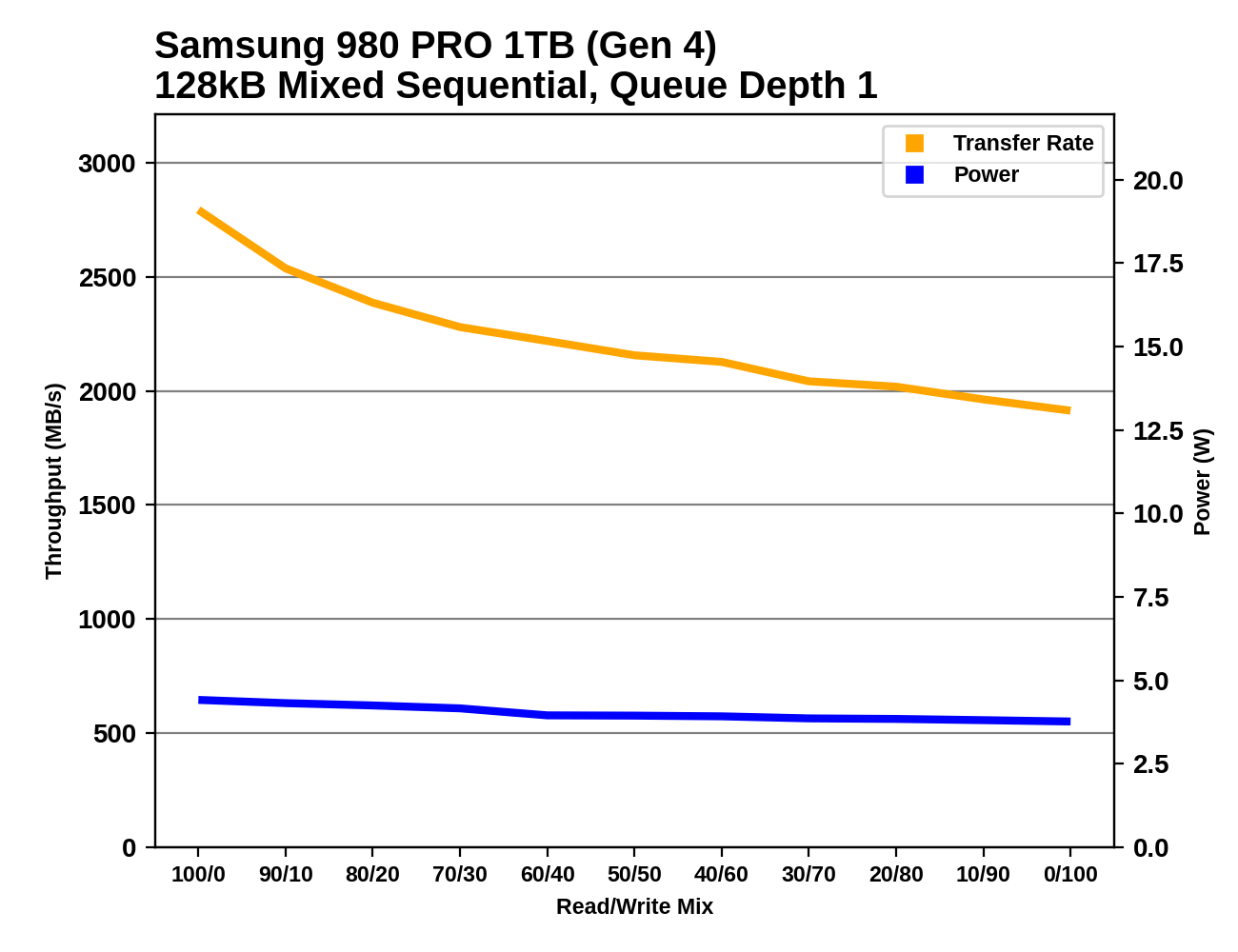The Samsung 980 PRO PCIe 4.0 SSD Review: A Spirit of Hope
by Billy Tallis on September 22, 2020 11:20 AM ESTNote: All our previous testing has been on an Intel test bed. Because of the move to PCIe 4.0, we have upgraded to Ryzen. Devices tested under Ryzen in time for this review are identified in the charts.
Mixed Random Performance
Our test of mixed random reads and writes covers mixes varying from pure reads to pure writes at 10% increments. Each mix is tested for up to 1 minute or 32GB of data transferred. The test is conducted with a queue depth of 4, and is limited to a 64GB span of the drive. In between each mix, the drive is given idle time of up to one minute so that the overall duty cycle is 50%.

Since our mixed random IO test uses a moderate queue depth of 4, the PCIe Gen4 drives don't get much chance to flex their muscle. The overall scores are still generally bound by NAND flash latency, which doesn't vary too widely between current generation drives. There's also a small performance boost when running this test on our newer, faster Ryzen testbed. The Samsung 980 PRO is clearly an improvement over its predecessors, but is merely tied for first place among flash-based drives with the SK hynix Gold P31.
 |
|||||||||
| Power Efficiency in MB/s/W | Average Power in W | ||||||||
Both capacities of the 980 PRO turn in good efficiency scores for the mixed random IO test, substantially improving on Samsung's previously mediocre standing. The 1TB 980 PRO's efficiency is second only to the SK hynix Gold P31. The 980 PROs are a bit more efficient running at PCIe Gen3 speeds than on the Gen4 platform, despite the ~10% performance boost on the faster system.
 |
|||||||||
There are no real surprises in the performance profiles of the 980 PROs. Both capacities show the same general behavior as earlier Samsung drives, albeit with small improvements to performance and power consumption across the board.
Mixed Sequential Performance
Our test of mixed sequential reads and writes differs from the mixed random I/O test by performing 128kB sequential accesses rather than 4kB accesses at random locations, and the sequential test is conducted at queue depth 1. The range of mixes tested is the same, and the timing and limits on data transfers are also the same as above.

The Samsung 980 PROs take the top spots for our mixed sequential IO test, with even the 250GB 980 PRO edging out the 1TB Seagate FireCuda 520. Even when limited to PCIe Gen3, the 980s are a clear step up in performance from eariler high-end drives. The improvement for the 250GB model is the most impressive, since the 250GB 970 EVO Plus is significantly slower than most of the 1TB drives.
 |
|||||||||
| Power Efficiency in MB/s/W | Average Power in W | ||||||||
The 980 PROs turn in more good power efficiency numbers that place them clearly ahead of everything other than the SK hynix Gold P31. And this time, the P31's efficiency lead relatively small at no more than about 25%.
 |
|||||||||
The 980 PROs show a drastically different performance profile compared to earlier Samsung drives. The 970s tend to bottom out during the write-heavy half of the test and recover some performance toward the end. Now with the 980 PRO, performance in the write-heavy half doesn't drop precipitously, so we see a steady decline that most closely resembles how the Intel Optane SSD handles this test










137 Comments
View All Comments
Luckz - Thursday, September 24, 2020 - link
At reasonable things like 4K random IOPS, the 1TB P31 seems to crush the 2TB Evo Plus.Notmyusualid - Tuesday, October 6, 2020 - link
@ Hifi.. - yes totally agree on the latency.That is why TODAY I just received my 1TB 970 Pro for my laptop. Even choosing it over the 980's... it was the Avg write latency table that sealed the deal for me. (See ATSB Heavy / Write)
My Toshiba X5GP 2TB (supposedly enterprise class ssd) is not able to keep up with the huge writes my system endures most days. My write performance drops by about 10x, and when I replay my data, there are clear drop-outs.
The loss of capacity will be a pain, but I'll push old data to the 2TB, as reads on that disk are normal, and if I need to work on a data set, I'll just have to pull it across to the 970 Pro again.
My 2c.
romrunning - Tuesday, September 22, 2020 - link
What this review has done for me is to whet my appetite for an Optane drive. I'm looking forward to seeing how the new AlderStream Optane drives perform!viktorp - Wednesday, September 23, 2020 - link
Right here with you. Goodbye Samsung, nice knowing you.Will advise all my clients to stay away form Samsung for mission critical storage.
Wish we had a choice of selecting SLC, MLC, TLC, trading capacity for reliability, if desired.
_Rain - Wednesday, September 23, 2020 - link
For the sake of your clients, please advice them to use enterprise drives for mission critical storage.Those Qvos, Evos and Pros are just client storage drives and not meant for anything critical.
and of course you can limit the drives capacity to lesser value in order to gain some spare endurance. For example quote 384GB on 512GB drive will definitely double your endurance.
FunBunny2 - Wednesday, September 23, 2020 - link
"please advice them to use enterprise drives for mission critical storage."does anyone, besides me of course, remember when STEC made 'the best enterprise' SSD? anybody even know about STEC? or any of the other niche 'enterprise' SSD vendors?
XabanakFanatik - Tuesday, September 22, 2020 - link
It's almost like my comment on the previous article about the anandtech bench showing the 970 Pro is still faster due to the move to TLC were accurate.On the random, when the 980 beats the 970 pro it's by the smallest margin.
Samsung has really let the professionals like myself that bought pro series drives exclusively down.
Not to mention over 2 years later than the 970 Pro and it's marginally faster sometimes outside raw burst sequential read/write.
Jorgp2 - Tuesday, September 22, 2020 - link
Don't all GPUs already decompress textures?And the consoles only have hardware compression to get the most out of their CPUs, same for their audio hardware, video decoders, and hardware scalers.
There's plenty of efficient software compression techniques, Windows 10 even added new ones that can be applied at the filesystem level. They have good compression, and very little overhead to decompress in real time.
Only downside is that it's a windows 10 feature, that means it's half baked. Setting the compression flag is ignored by windows, you have to compress manually every time.
Ryan Smith - Tuesday, September 22, 2020 - link
"Don't all GPUs already decompress textures?"Traditional lossy texture compression is closer to throwing data out at a fixed ratio than it is compression in the lossless sense. Compressed textures don't get compressed so much as texture units interpolate the missing data on the fly.
This is opposed to lossless compression, which is closer to ZIP file compression. No data is lost, but it has to be explicitly unpacked/decompressed before it can be used. Certain lossless algorithms work on compressed textures, so games store texture data with lossless compression to further keep the game install sizes down. The trade-off being that all of this data then needs uncompressed before the GPU can work on it, and that is a job traditionally done by the CPU.
jordanclock - Thursday, September 24, 2020 - link
This fast of a drive combined with DirectStorage has me very excited for this particular reason. Though, as I understand it, DirectStorage requires the game to explicitly call the API and thus needs to be built into the game, as opposed to a passive boost to every game.